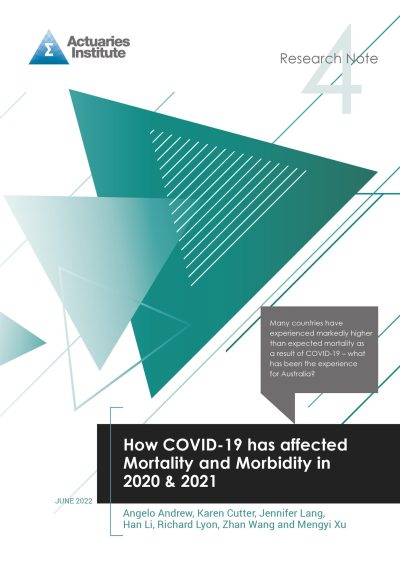
Actuaries Institute research shows true impact of COVID-19 pandemic on excess mortality in 2020-21
The latest Actuaries Institute Research Note, How COVID-19 has affected Mortality and Morbidity in 2020 & 2021, sheds light on Australia’s experience during the pandemic in a global context.
Written by the Institute’s COVID-19 Mortality Working Group, the latest note shows Australian mortality is 1% lower than expected for 2020-21.
This is compared with a global average of 17% higher than expected mortality across 37 countries during the pandemic in 2020 and 2021. Excess deaths ranged from -4% (New Zealand) to +84% (Peru), with 5.7 million excess deaths over two years.

However, Australia’s Omicron deaths up to 31 March 2022 have eliminated the 2020-21 mortality savings.
The Working Group, consisting of actuaries Angelo Andrew, Karen Cutter, Jennifer Lang, Han Li, Richard Lyon, Zhang Wang and Mengyi Xu, anticipate higher insurance claims and potentially higher premiums for all disability-related insurance.
The Institute’s ‘excess mortality’ model measures actual deaths against predicted deaths, in total and across each cause of death and age band. The prediction allows for changes in the size and age of the population and for trends in mortality improvement.
The 2021 analysis by age band revealed surprising results including significantly lower deaths in the 45-64 age band, significantly higher in the 75-84 age band, and close to expected in the 85+ band. The reason for the differences is unclear.
“Perhaps the differences between the two oldest age bands are due to higher levels of protection in aged care homes, home care and hospitals than in the general community, possibly leading to much fewer-than-expected deaths from respiratory disease,” the report said.
The authors noted the sharp rise in COVID-19 deaths for the first quarter of 2022, with just over 4,000 COVID-19 deaths, following the relaxation of public health measures. This is almost two-thirds of the 6,341 COVID-19 deaths over the course of the pandemic up to the end of March 2022, and it has resulted in the elimination of the negative excess mortality experienced in 2020 and 2021.
Figure 1: Estimated cumulative excess deaths in Australia since the start of 2020

Institute President Annette King said the COVID-19 Mortality Working Group, and actuaries broadly, have provided unique insights into the pandemic.
“Actuaries use their skills to advise on a wide range of current issues and public policy,” Annette said.
“During the pandemic, they looked at the patterns of data to help policymakers and the public understand the impact of this unprecedented public health crisis.”
The authors also examined Long COVID. It is too early to determine the long-term effects of Long COVID, according to co-author Jennifer Lang.
“But we need to be ready. There are more people who are long-term disabled than there were before COVID,” Jennifer said.
The authors anticipate higher insurance claims and potentially higher premiums for all disability-related insurance – including income protection, workers’ compensation and Group Total and Permanent Disability.
The Working Group believe that Long COVID will require:
- Better health care for long-term illness, such as investment in more health care workers, Long COVID clinics, and other supports in the health care system
- Income support for those unable to work, or who have reduced ability to work, due to Long COVID
- Support in the workplace to enable affected workers to continue working while suffering Long COVID symptoms.
This Research Note supplements the authors’ regular analysis of monthly ABS mortality statistics, the latest of which is available here.
CPD: Actuaries Institute Members can claim two CPD points for every hour of reading articles on Actuaries Digital.






